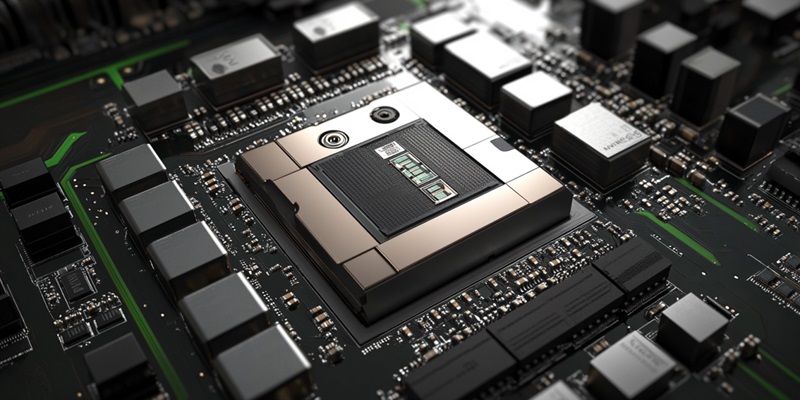Nvidia’s eagerly awaited RTX 5060 GPU has been a hot topic within the tech community, triggering a wave of speculation and curiosity about its capabilities. Among the most thrilling updates are the anticipated reductions in power consumption and the inclusion of next-generation GDDR7 memory. These advancements promise not just better performance but also enhanced efficiency, which could redefine the user experience for gamers, professionals, and tech enthusiasts alike. Below, we delve into these groundbreaking aspects and what they mean for potential consumers of this new technology.
Lower Power Consumption: A Game Changer
Recent statements from Chairman Wu Haijun of Shenzhen Hasee Computer Co. have shed new light on the expected power requirements of the RTX 5060, upending earlier speculations. Contrary to previous rumors that suggested a 55W increase, the RTX 5060 laptop GPU is now expected to require only 115W of power. This marks a significant reduction from the 140W needed by its predecessor, the RTX 4060, hinting at potentially revolutionary changes in power efficiency.
The advantages of this lower power requirement are manifold. For starters, it directly impacts device battery life, a critical factor for gamers and professionals who rely on extended use without frequent recharging. Additionally, the reduced power consumption leads to less heat generation, improving the overall thermal management of laptops and desktop systems. This can result in quieter cooling solutions and potentially longer hardware lifespans, which would be a welcome relief to users who push their systems to the limit.
While power efficiency stands out as a highlight, it remains to be seen how Nvidia balances this with performance enhancements. Historically, reductions in power consumption often come alongside architectural tweaks and manufacturing improvements that boost processing efficiency. Thus, expectations remain high for this new GPU as users hope for a balance between power efficiency and performance prowess. Only time and comprehensive reviews will reveal whether these expectations will be met.
Inclusion of GDDR7: Setting the Stage for Performance Boosts
Apart from power efficiency, another exciting development is the inclusion of GDDR7 memory in the RTX 5060. This next-generation memory technology has been a consistent theme in various leaks, adding to its credibility. GDDR7 memory promises faster data transfer rates, which could lead to better performance in gaming and professional applications, marking a considerable upgrade over GDDR6.
The move to GDDR7 memory indicates Nvidia’s commitment to keeping the RTX 5060 relevant in increasingly demanding computational environments. Faster memory can significantly speed up intensive tasks such as rendering, data computation, and gaming at higher resolutions and settings. Even though the VRAM for the RTX 5060 may remain at 8GB, the efficiency gains from GDDR7 should not be underestimated. Faster memory transfer rates translate to quicker load times and a smoother experience for end-users, making it a notable feature of this upcoming GPU.
GDDR7 also aligns with broader industry trends, pushing the envelope in performance while potentially offering more energy-efficient operations compared to previous generations like GDDR6. As games and applications become more complex, the need for faster and more capable memory becomes paramount. It seems Nvidia is stepping up to meet this challenge with the RTX 5060, which could be a game-changer for various computational needs. The inclusion of GDDR7 stands as a testament to Nvidia’s ongoing commitment to innovation and performance improvement.
Expectations and Strategic Diversifications within the RTX 5000-Series
The RTX 5060 is part of Nvidia’s broader strategy within the mobile RTX 5000-series, a lineup expected to feature a range of models designed to cater to diverse needs. For instance, the series might include GN22-X11 and X9 SKUs that run at 175W Total Graphics Power (TGP), while other models like the X7, X6, X4, and X2 are expected to be capped at 115W. This variety in TGP values speaks to Nvidia’s strategic intent to offer various power-performance configurations tailored to different user requirements.
This tiered approach allows Nvidia to cater to multiple segments within the gaming and professional markets, providing options for both power-hungry enthusiasts and those prioritizing power efficiency. The absence of older-generation counterparts for certain models, like the X7, might also suggest a new strategy aimed at addressing unmet demands or emerging market trends. By innovating across their product range, Nvidia can better position itself against competitors, providing users with a carefully curated selection of GPUs tailored to a wide array of needs.
This expansion moves beyond simply keeping up with market trends. It implies a more calculated effort to carve out new niches and provide customized solutions for varying consumer demands. By focusing on both high performance and efficient operations, Nvidia ensures that they capture a broader spectrum of the GPU market. This level of strategic diversification could prove essential in maintaining Nvidia’s edge in a highly competitive industry where user requirements are becoming increasingly specialized.
Balancing Performance and Efficiency: The Way Forward
Nvidia’s highly anticipated RTX 5060 GPU is generating a significant buzz within the tech community, sparking immense speculation and curiosity about its features and performance. One of the most exciting updates is the expected reduction in power consumption, a crucial aspect that could lead to quieter and cooler systems, while also being environmentally friendly. Another impressive advancement is the integration of next-generation GDDR7 memory. This upgrade is expected to offer faster data rates and improved performance, making it an attractive option for hardcore gamers, professionals, and tech enthusiasts alike.
These enhancements herald a new era of efficiency and power, promising not just superior performance but also an improved overall user experience. The combination of reduced energy consumption and advanced memory capabilities means users can look forward to a GPU that is both powerful and efficient, addressing a wide range of needs from intense gaming sessions to demanding professional applications. Let’s explore these groundbreaking features and their implications for future technology consumers.

